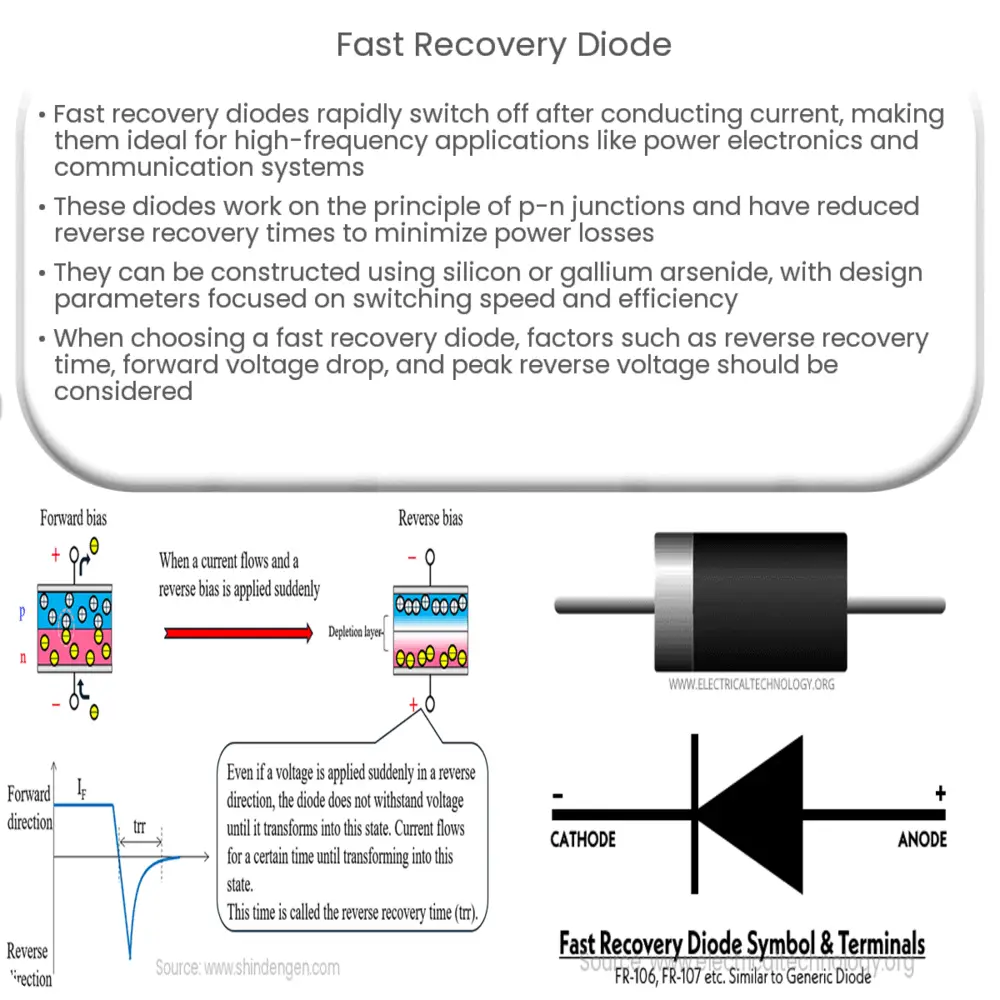A fast recovery diode is a semiconductor device with rapid switching capabilities, ideal for high-frequency applications in power electronics, communication systems, and digital circuits.

Fast Recovery Diode: An Overview
Introduction
A fast recovery diode is a specialized semiconductor device designed to switch off rapidly after conducting current. This characteristic makes them highly suitable for high-frequency applications, such as power electronics, communication systems, and high-speed digital circuits. In this article, we will discuss the working principle, construction, and applications of fast recovery diodes, highlighting their importance in today’s electronic devices.
Working Principle
Fast recovery diodes operate on the principle of p-n junctions, which are formed by the interaction of p-type and n-type semiconductor materials. When a forward bias is applied across the diode, current flows through the p-n junction as the electrons from the n-side recombine with holes in the p-side, releasing energy in the form of light or heat. During this process, a small number of carriers are stored in the junction, contributing to a phenomenon known as reverse recovery time (trr).
Reverse recovery time is the period it takes for a diode to stop conducting current once the applied voltage is reversed. Fast recovery diodes are engineered to have significantly reduced reverse recovery times, enabling them to switch off rapidly and minimize power losses in high-frequency applications.
Construction
Fast recovery diodes are typically constructed using silicon or gallium arsenide (GaAs) semiconductor materials. Silicon-based diodes offer a good balance between switching speed and cost, while GaAs-based diodes deliver higher performance with faster switching speeds but at a higher price point. Key design parameters for fast recovery diodes include:
- Reverse recovery time (trr): The shorter the trr, the faster the diode can switch off and the better it is suited for high-frequency applications.
- Forward voltage drop (Vf): Lower Vf values result in reduced power losses during conduction, improving overall efficiency.
- Peak reverse voltage (PRV): A higher PRV rating indicates the diode’s ability to withstand higher reverse voltage without breakdown.
- Average forward current (If(av)): This parameter specifies the maximum average forward current the diode can handle without overheating.
Applications
Fast recovery diodes find widespread use in various high-frequency electronic applications, such as:
- Power Electronics: Fast recovery diodes are commonly used in power converters, inverters, and motor drives to minimize switching losses and improve efficiency.
- Communication Systems: In high-frequency communication systems, fast recovery diodes can be employed as switches, mixers, or detectors to facilitate signal processing and transmission.
- High-Speed Digital Circuits: Fast recovery diodes are an essential component in high-speed digital circuits, where they help reduce signal distortion and improve overall performance.
Advantages of Fast Recovery Diodes
Fast recovery diodes offer several advantages over conventional diodes, including:
- Reduced Switching Losses: Due to their rapid switching capabilities, fast recovery diodes minimize power losses during the switching process, leading to higher overall efficiency in electronic systems.
- Improved Performance in High-Frequency Applications: The short reverse recovery time of fast recovery diodes makes them well-suited for high-frequency applications where conventional diodes may struggle to perform effectively.
- Enhanced Reliability: Fast recovery diodes can handle higher peak reverse voltages and average forward currents, making them more resilient to potential damage and extending the lifespan of electronic systems.
Selection Criteria
When selecting a fast recovery diode for a particular application, several factors should be considered:
- Reverse Recovery Time: Choose a diode with a reverse recovery time suitable for the intended application’s frequency requirements.
- Forward Voltage Drop: Select a diode with a low forward voltage drop to minimize power losses and improve overall efficiency.
- Peak Reverse Voltage: Ensure the diode’s peak reverse voltage rating is sufficient to withstand the maximum reverse voltage encountered in the application.
- Average Forward Current: Verify that the diode can handle the maximum average forward current without overheating or degrading its performance.
- Package Type and Size: Consider the physical dimensions and mounting requirements of the diode to ensure compatibility with the existing system.
Conclusion
Fast recovery diodes are essential components in modern high-frequency electronic systems, offering improved performance, efficiency, and reliability compared to conventional diodes. With their rapid switching capabilities and ability to withstand higher peak reverse voltages and average forward currents, fast recovery diodes are well-suited for applications in power electronics, communication systems, and high-speed digital circuits. By considering the factors outlined in this article, engineers and designers can select the most appropriate fast recovery diode for their specific application requirements, resulting in enhanced performance and longevity of electronic systems.

